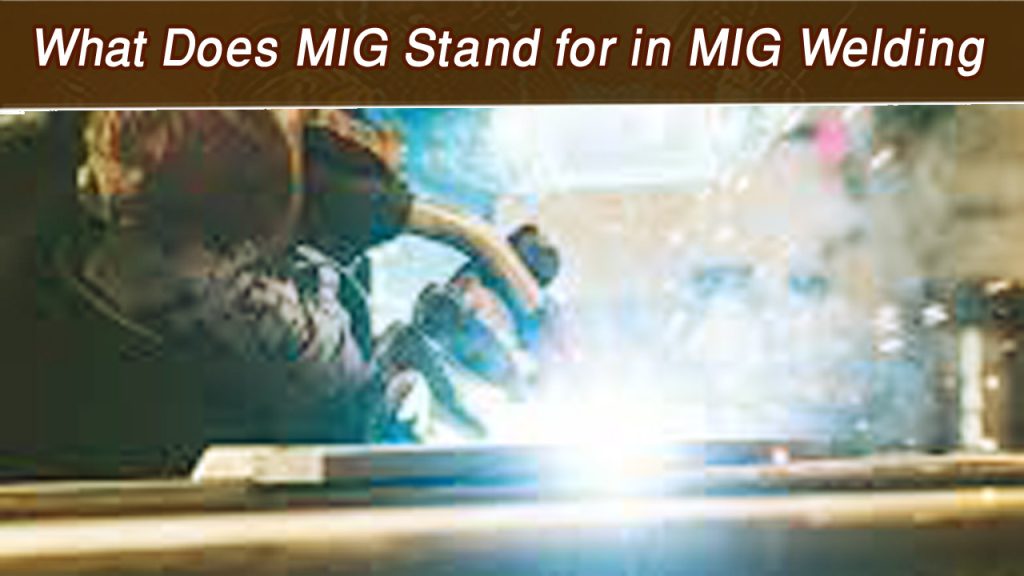If you’ve ever walked into a workshop or watched a welding project in action, you might have heard the term “MIG welding.” It’s a widely popular welding method used in industries and even for home repairs. But have you ever wondered what MIG stands for? Let’s break it down and explore everything you need to know about this fascinating process.
I’ve had my fair share of experience with MIG welding, and I know it’s one of the easiest and most efficient welding methods out there. Whether you’re a beginner or just curious about the terminology, this article will guide you through the basics and beyond.

Image by seaberyat
What Does MIG Stand For?
MIG stands for Metal Inert Gas. It’s a type of welding that uses a shielding gas to protect the weld from atmospheric contamination. The full technical term is Gas Metal Arc Welding (GMAW), but MIG welding is the more common name.
This process is all about using a consumable wire electrode and an inert gas—like argon or a mix of argon and carbon dioxide—to create clean and strong welds.
How MIG Welding Works
The MIG welding process might sound complex, but it’s quite straightforward once you break it down. Here’s a simple explanation:
- A spool of wire (the consumable electrode) feeds continuously through a welding gun.
- An electric arc forms between the wire and the base material, generating heat to melt the metal and form the weld.
- The inert gas flows through the nozzle of the welding gun, shielding the weld pool from oxygen and moisture in the air, which could otherwise weaken the weld.
This setup creates a stable and controlled environment, making MIG welding one of the easiest techniques to learn and master.
Why Is the Shielding Gas Important?
The shielding gas is a key part of MIG welding. It acts as a protective barrier, ensuring the molten weld pool doesn’t get contaminated by elements like oxygen and nitrogen from the atmosphere.
Common Shielding Gases Used in MIG Welding
| Gas Type | Best For | Advantages |
|---|---|---|
| Argon | Aluminum, stainless steel | Produces smooth, clean welds. |
| Carbon Dioxide (CO₂) | Mild steel | Affordable, offers deep penetration. |
| Argon-CO₂ Mix | General-purpose welding | Combines the benefits of both gases. |
| Helium | Specialty applications (e.g., thick materials) | Increases heat for deeper weld penetration. |
Advantages of MIG Welding
One reason MIG welding is so popular is because of its many advantages. Here’s why it’s a go-to method for many welders:
Ease of Use
MIG welding is beginner-friendly. With a steady hand and some practice, anyone can pick it up quickly.
Speed and Efficiency
The continuous wire feed means there’s no need to stop and change electrodes, making the process faster than other methods like stick welding.
Versatility
MIG welding works well on various metals, including steel, stainless steel, and aluminum.
High-Quality Welds
The shielding gas ensures clean, strong, and visually appealing welds with minimal spatter.
Disadvantages of MIG Welding
While MIG welding is fantastic, it’s not without its challenges.
Higher Initial Cost
MIG welders and shielding gases can be expensive, especially for hobbyists.
Limited Outdoor Use
Wind can blow away the shielding gas, compromising weld quality.
Requires Clean Surfaces
The metal surface needs to be free of rust, paint, and debris for optimal results.
Dependence on Electricity
MIG welding relies on a constant power source, which might not be available in remote locations.
Common Applications of MIG Welding
MIG welding is used in a variety of industries and projects. Its versatility makes it a favorite for:
- Automotive Repairs: Perfect for fixing body panels and frames.
- Construction: Used for structural welding and pipe joints.
- Manufacturing: Ideal for producing tools, appliances, and furniture.
- Hobby Projects: Great for DIY projects like garden equipment or metal sculptures.
Tips for Getting Started with MIG Welding
If you’re new to MIG welding, here are some beginner-friendly tips:
- Invest in Quality Gear: A reliable MIG welder, safety helmet, and gloves are non-negotiable.
- Practice Makes Perfect: Start with scrap metal to get the hang of controlling the arc and wire feed speed.
- Understand Your Settings: Adjust voltage, wire speed, and gas flow to suit the metal you’re welding.
- Stay Safe: Always wear protective gear, and work in a well-ventilated area to avoid inhaling fumes.
DIY vs Professional MIG Welding
MIG welding is beginner-friendly, but some projects are better left to professionals.
DIY MIG Welding
- Perfect for small projects like garden gates or repairing car parts.
- Cost-effective and gives you the satisfaction of creating something yourself.
Professional MIG Welding
- Necessary for critical applications like structural repairs or large-scale projects.
- Ensures compliance with industry standards and safety requirements.
Conclusion
So, what does MIG stand for in MIG welding? It’s Metal Inert Gas—a method that’s revolutionized the welding world with its ease of use, versatility, and efficiency.
If you’re tackling a DIY project at home or considering a career in welding, understanding the basics of MIG welding gives you a solid foundation. From choosing the right shielding gas to mastering the techniques, this process is an excellent choice for beginners and professionals alike.
Remember, practice and safety are key. With time and effort, you can achieve clean, strong welds that stand the test of time.
FAQs
What’s the difference between MIG and TIG welding?
MIG welding uses a consumable wire electrode and shielding gas, while TIG welding uses a non-consumable tungsten electrode and requires more skill.
Can MIG welding be done without gas?
Yes, gasless MIG welding (also known as flux-cored arc welding) uses a special wire with built-in flux, eliminating the need for external shielding gas.
Is MIG welding good for beginners?
Absolutely! MIG welding is one of the easiest welding methods to learn, making it ideal for beginners.
What metals can be welded with MIG welding?
MIG welding works well with steel, stainless steel, and aluminum.
How do I choose the right shielding gas for MIG welding?
It depends on the metal you’re welding. Argon is great for aluminum, CO₂ is cost-effective for steel, and a mix of argon and CO₂ offers versatility.

Endow Russel the owner chief editor of giftendow.com . I am a mechanical engineer and assign to an local firm with much experience in welding and industrial equipment.

